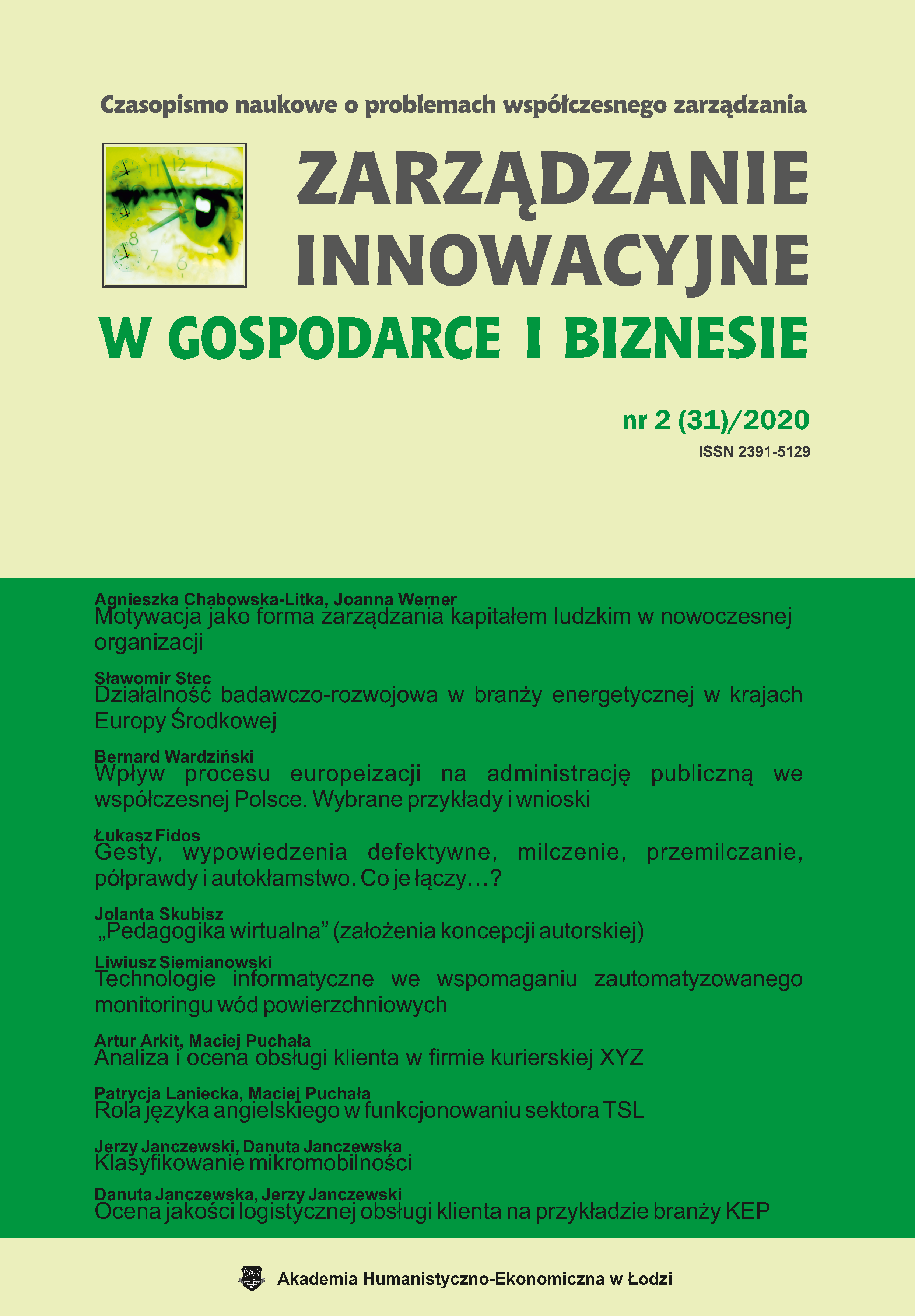Research and development activities in the energy industry in Central European countries
DOI:
https://doi.org/10.25312/2391-5129.31/2020_02ssKeywords:
innovation, research and development, research personnel, Visegrad Group, energy sectorAbstract
The article contains a synthetic description of activities related to innovation in the energy industry in the countries of Central Europe, namely in the Czech Republic, Poland, Slovakia and Hungary in the years 2009–2018. It takes into account government spending on research and development in the said industry. In addition, the condition of R&D personnel and the number of intellectual property rights obtained in the activities in the field of electricity, gas, steam and air conditioning supply were analysed. The article analyses the barriers that contribute to reducing the dynamics of innovation development and reducing the interest in research and development in the discussed energy sector. It also presents tax incentives in individual countries related to conducting innovative activities. The research shows that the indicators of innovation in the electricity supply sector are at a low level, and the trends of the last decade indicates slight changes in this respect. The above-mentioned barriers to the implementation of innovations mainly indicate problems with financing them, as well as bad experiences during the earlier application of innovations. Therefore, it is concluded that there are many tasks ahead of the governments of the discussed countries to intensify activities aimed at the fastest possible development of R&D in the electricity supply sector, and in particular to launch increased financial flows, maintain the policy of applying tax breaks for innovative activities, promoting innovation.
Downloads
References
Badania naukowe i innowacje (2014), Komisja Europejska, Urząd Publikacji Unii Europejskiej, Luksemburg, https://ec.europa.eu/programmes/horizon2020/sites/default/files/H2020_PL_KI0213413PLN.pdf [dostęp: 2.09.2020].
Bointner R. (2014), Innovation in the energy sector: Lessons learnt from R&D expenditures and patents in selected IEA countries, “Energy Policy”, 73.
Costa-Campi M.T., Duch-Brown N., Garcia-Quevedo J. (2014), R&D Drivers and obstacles to innovation in the energy industry, “Energy Economics”, 46.
Cztery filary polityki innowacyjnej Polski (2019), Narodowe Centrum Badań i Rozwoju, https://www.ncbr.gov.pl/o-centrum/aktualnosci/szczegoly-aktualnosci/news/cztery-filary-polityki-innowacyjnej-polski-60203/ [dostęp: 2.09.2020].
Działalność innowacyjna. Słownik pojęć (2019), Główny Urząd Statystyczny, Warszawa, https://stat.gov.pl/metainformacje/slownik-pojec/ [dostęp: 3.09.2020].
Europa 2020: Strategia Unii Europejskiej na rzecz wzrostu gospodarczego i zatrudnienia (2010), Komisja Europejska, https://eur-lex.europa.eu/legal-content/en/ALL/?uri=CELEX%3A52010DC2020 [dostęp: 2.09.2020].
Eurostat, European Statistical, https://ec.europa.eu/eurostat/data/database [dostęp: 3.09.2020].
Innováció vagy kutatás-fejlesztés? (2019), Glósz és Társa Financial, Economic and Innovation Consulting Ltd., https://innovacio-menedzsment.hu/kutatas-fejlesztes-innovacio [dostęp: 4.09.2020].
Inovační strategie České republiky na období 2019–2030 (2019), Rada pro výzkum, vývoj a inovace, Praha.
Kormány A. (2013), Korm. Határozata a Kormány középtávú tudomány-, technológia-és innováció-politikai stratégiájáról szóló (1413/2013), (VII. 4.), Budapeszt.
Mi a különbség kutatás-fejlesztés és innováció között? (2020), Glósz és Társa Kft, https://glosz.eu/innovacio-kutatasfejlesztes [dostęp: 4.09.2020].
Moris F. (2018), Definitions of Research and Development: An Annotated Compilation of Official Sources, National Science Foundation, https://www.nsf.gov/statistics/randdef/#chp2&chp3&chp4 [dostęp: 12.09.2020].
Nauka i technika w 2018 roku (2020), Główny Urząd Statystyczny, Warszawa–Szczecin.
Podręcznik Frascati 2015. Pomiar działalności naukowo-technicznej i innowacyjnej (2015), Organizacja Współpracy Gospodarczej i Rozwoju OECD.
Poznatkami k prosperite – Stratégia výskumu a inovácií pre inteligentnú špecializáciu Slovenskej republiky (RIS3) (2013), Ministerstvo školstva, vedy, výskumu a športu Slovenskej republiky.
Rozporządzenie Rady Ministrów z dnia 24 grudnia 2007 r. w sprawie Polskiej Klasyfikacji Działalności (PKD), Dz.U. 2007, nr 251, poz. 1885.
The Measurement of Scientific and Technological Activities Proposed Guidelines for Collecting and Interpreting Technological Innovation Data (2018), Organisation for Economic Co-operation and Development (OECD), European Union, Luxembourg, https://www.oecd-ilibrary.org/docserver/9789264304604-en.pdf?expires=1576766809&id=id&accname=guest&checksum=08D43F7F-9061C44B979911B9B46BEB26 [dostęp: 3.09.2020].
Výzkum a vývoj. Český statistický úřad (2020), Český statistický úřad, https://www.czso.cz/csu/czso/statistika_vyzkumu_a_vyvoje [dostęp: 3.09.2020].
Základní pojmy výzkumu a vývoje v OECD a EU (1994), Úřadu vlády ČR, https://www.vyzkum.cz/FrontClanek.aspx?idsekce=932 [dostęp: 3.09.2020].
Zákon o organizácii štátnej podpory výskumu a vývoja a o doplnení zákona č. 575/2001 Z. z. o organizácii činnosti vlády a organizácii ústrednej štátnej správy v znení neskorších predpisov (Zákon č. 172/2005 Z.z.).
Zákon o organizácii štátnej podpory výskumu a vývoja a o zmene a doplnení zákona č. 575/2001 Z.z. o organizácii činnosti vlády a organizácii ústrednej štátnej správy (Zákona č. 575/2001 Z.z.).
Downloads
Published
Issue
Section
License
Copyright (c) 2021

This work is licensed under a Creative Commons Attribution-ShareAlike 4.0 International License.

